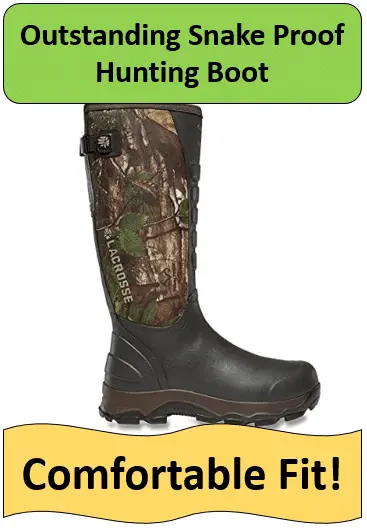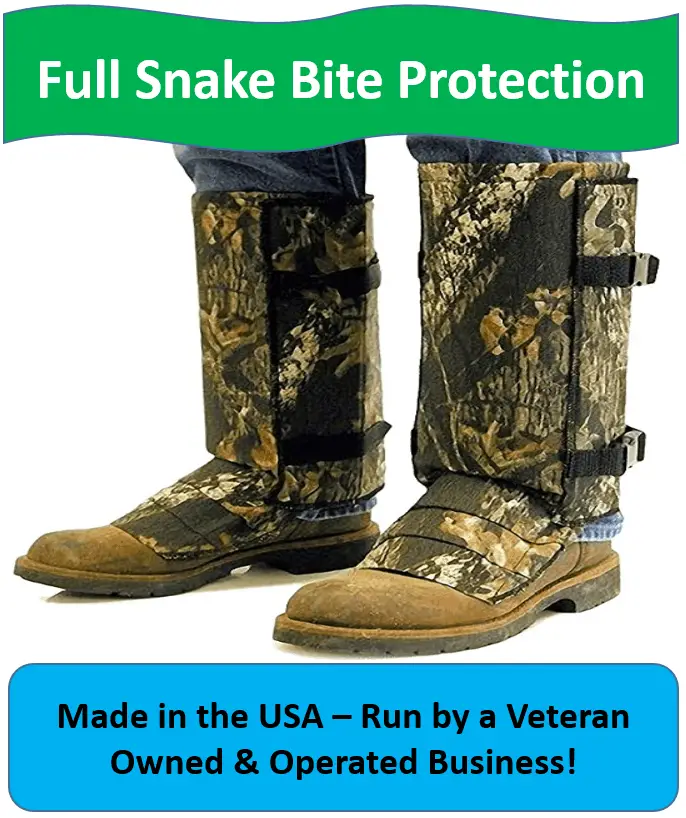Rattlesnake bites are considered a medical emergency for good reason. The venom of these snakes is capable of damaging tissues and inducing an internal hemorrhage that eventually leads to loss of limb or even death. Very few people die now of rattlesnake bites but mostly because of advanced medicine like anti-venom.

Can denim jeans stop a rattlesnake bite? Technically, yes, a little bit.
But is it enough? Absolutely not.
Untreated bites can cause severe medical problems or even lead to death. So it’s better not to take any chances and protect yourself properly.
What are the alternatives? Keep reading to discover! I’ll explore the efficacy of denim in detail and introduce more effective methods.
Table of Contents
How Much Protection Can Denim Jeans Offer?
You might be wondering: “How can we tell whether denim would provide enough protection against a venomous snake bite?” After all, we couldn’t actually experiment with snake bites on humans, or even animals.
Luckily, two researchers were able to devise a brilliant methodology. In their study, Shelton Herbert and William Hayes used latex gloves filled with saline solution to replicate a human hand.
This was unique for two reasons. First, latex flexibility closed the bite holes immediately. This way, the researchers could measure the amount of venom released in the saline solution.
Secondly, the latex texture, along with the weight of the saline solution, would trick the snakes into believing they’re actually biting humans. This is important since a snake could bite stronger and release more venom when intimidated.
To carry on with the test, the researchers used 8 small and 9 large southern Pacific rattlesnakes. This is a solid choice since these rattlesnakes tend to be fairly high on the dangerous venom side of the scale when it comes to rattlesnakes native to the United States.
“The southern Pacific rattlesnakes rapidly attack the victim’s nervous system, possibly triggering problems in breathing, loss of muscle control, and collapse into a coma,” says Dr. Sean Bush, a professor in Loma Linda University.
The Results: Surprising Performance from Denim
Before introducing the gloves to the snakes, they covered one with a loose layer of denim and left the other one bare.
The results revealed 60% less venom in the denim-covered gloves that were bitten by small snakes and 66% less venom in gloves bit by the large ones.
These results tell us that the secret doesn’t lie in the material thickness. Otherwise, the large snakes should’ve been able to tear up through the fabric and inject higher venom.
That leaves us with only one conclusion, the denim itself holds a protective value against rattlesnakes. Not enough to straight up stop a bite, but enough to lessen the severity of the bite – and that means a lot.
The researchers reasoned that the texture of the denim made the snakes believe they successfully penetrated their enemy, causing them to release their venom prematurely.
They proved this theory when they found that 43% of the overall venom ended up inside the fabric rather than the latex gloves.
The Conclusion: Denim Is Better Than Shorts, but Still Far from Being Sufficient
If you’ll go on hiking or hunting trips, never wear shorts. Going with bare legs might be the “cool” way, but it certainly isn’t worth the risk.
Denim is a simple, yet effective material to protect yourself from around 60% from rattlesnake bites. But should we take chances with the other 40%? No.
Keep in mind that if denim is skin tight the protection likely isn’t the same. Having loose denim off of the leg could also provide some space that gives even a bit more protection, but that’s hard to confirm.
So, If Denim Won’t Work, What Will?
To stack the odds in your favor, your best bet would be snake-proof gaiters or snake boots. Their leather and rubber construction would be harder for rattlesnakes to penetrate.
Wear Lacrosse Snake Boots for the Ultimate Protection
Without a doubt, snake boots are the best protective garment to stop rattlesnake bites. We talk about this a lot and even have our article of best snake boots.
When you’re looking for good snake boots look for good reliable brands like Chippewa or Lacrosse that have a good reputation and long history of protection.
A lot of their snake boots incorporate leather, rubber, neoprene, and polyurethane. This doesn’t only provide unmatched protection, it also allows you to walk freely for a long distance without feeling pain.
Best of all, they have one of the best quality control measures in the industry. For instance, every boot is sent for testing in a third-party lab, where various penetration tests are held.
To make sure results are accurate, they put inflated, delicate balloons inside the boots. This way, they’ll instantly know if a boot allows the slightest bit of penetration.
Or Put on a Pair of Snake-Proof Gaiters
Boots aren’t for everyone. Yes, some are lightweight to allow freer movement, but they’ll still feel heavier than regular shoes. Not to mention that boots usually don’t fit a medium budget. If this applies to you, the second-best thing is snake-proof gaiters.
Take the Crackshot snake-proof gaiters, for example. I love how they securely fit all the way up to your calves.
They also feature a small projection to cover the metatarsal region. This is absolutely important since snakes would likely bite there more than any other part.
However, they have a nylon construction instead of leather or rubber. Nylon is a bit stronger than denim, but it doesn’t provide full protection either.
Moreover, opting for gaiters means that the rest of your foot is left exposed, especially if you’re wearing regular canvas shoes, for instance.
So, considering that you’ll need to invest in snake-proof shoes in addition to the gaiters, snake boots seem to be the best option.
Bonus: What to Do If You Were Bitten?
Hopefully, your trip would be seamless, safe, and most importantly, super fun. However, wearing protective garments doesn’t mean you shouldn’t be prepared for emergency situations.
First things first, treat all snake bites as potentially venomous until proven otherwise. After a snake bites you, don’t try to catch, identify, or kill it. Just try to remember its features and color to give the doctors a heads-up about its type.
If possible, try to stay put and call for an ambulance. If you’re out in the wild, walk slowly toward the nearest road and wait for an ambulance. The movement could push the venom deeper into your body.
Oh, and please, do yourself a favor and forget whatever you saw in the movies. Don’t suck, cut, tourniquet, or even wash the wound. These actions would make it harder for the hospital staff to identify the snake and deliver appropriate treatment. Stay away from the snake bite kit scam, as well. They don’t work.
Final Thoughts
Can denim jeans stop a rattlesnake bite? Yes, but they’ll only stop 60% percent of the venom.
What are the alternatives? Snake boots provide absolute protection. If you can’t afford them, then heavy snake-proof gaiters could suffice.
Best of all, you can wear tall, loose denim jeans to extend over the neck of snake boots. It’ll be nearly impossible to get bitten this way.
Last, stay safe and treat snake bites promptly. Prevention is the best measure of protection from venomous snakes but barring that, get treatment. The sooner you get anti-venom and a proper checkup from the hospital, the less the long-term damage.



